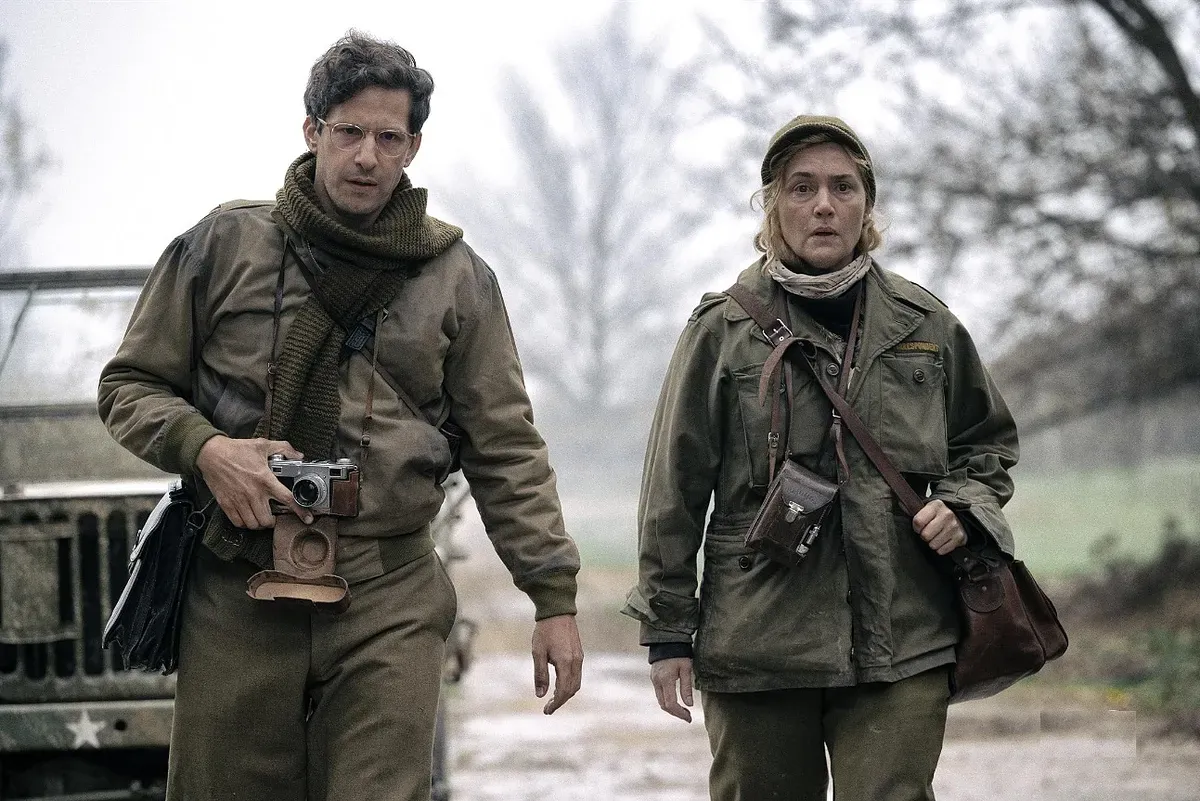Lee
Real Art Ways
Hartford
Sept. 30, 2024
Note: This review contains spoilers.
Lee is a biopic about Elizabeth “Lee” Miller, one of the best-known photographers of the Second World War. The movie is framed as her telling an unnamed reporter about her work for British Vogue during the war (more on that later), and follows her from the sunny days of drinking wine and socializing with her friends all the way through the end of the war and the terrible discoveries hidden within the Third Reich.
Kate Winslet plays Lee with an edge that is evident from the moment she meets her future husband, Roland Penrose (Alexander Skarsgård) in the first few moments of the movie. Winslet keeps Lee razor sharp throughout the movie, but does an excellent job of portraying the range of emotions Lee experienced while crossing Europe during the war, such as when she entered combat for the first time or found long lost friends who had been changed by their experiences.
One of the pleasant surprises of the movie is Andy Samberg’s turn as David Scherman, a Life reporter who becomes Lee’s partner. Samberg isn’t there to tell jokes or lighten the mood. But his bright smile and generally affable demeanor are a strong contrast to Lee’s no-nonsense approach.
The movie takes a standard approach to telling its story, presented as flashbacks when the reporter asks Lee his questions, until the last ten minutes or so. The big twist at the end of the movie is that Lee hasn’t been telling her story to just any reporter: she is to her son Antony (Josh O’Connor).
A few moments later, the other shoe drops — Lee hasn’t been talking at all. As the movie reveals in the epilogue, Lee Miller died without ever telling her son about the work she’d done as a photographer. The conversation Antony has been having for the entire movie is an imaginary one, where he’s using the photographs to get to know the woman he feels estranged from better.
This decision feels like it completely erases Lee Miller from the movie. Plenty of historical movies use the narrative device of a reporter asking questions to frame their main character’s course through time, but this is the first film I can think of where the subject literally vanishes at the end of the interview. It takes the movie from a story about Lee Miller’s courage and tenacity, and turns it into Antony working out his mommy issues. It’s an unfortunate irony that in a movie where the main character constantly fights back against discrimination because she’s a woman — she is ultimately removed from her own story.
I also never got much of a sense of how important Lee’s photography was, or her impact as a woman photographer. We’re never shown the broader impact of her work back home, as the story and camera rarely deviate from Lee herself. The movie also treats her as a daredevil bent on bucking the rules for their own sake, not someone who is genuinely interested in photojournalism, witnessing, truth-telling or any of the other motivators that drive someone like her forward. It also doesn’t show her as a pioneer trying to improve the status or opportunities of women.
And that’s fine! Not everyone is a crusader, and not everyone is motivated by lofty or noble ideals. However, in this case, that lack of deeper commitment to an ideal, any ideal, combined with the revelation that all of her words are in Antony’s head anyway, further diminishes her centrality in her own story. Eventually it starts to feel like Lee is being swept along by events, particularly when she and Scherman reach the horrors of the concentration camps.
Even in those dark moments, Lee is robbed of the depth that should be afforded her. Her decision to take a picture in Hitler’s bathtub is treated as another flighty moment instead of a political or social statement. Instead, a few moments later Scherman breaks down over the horrors of the Final Solution. Lee’s emotional moment comes later in the film, when she finds that her British editor has declined to publish her pictures of the concentration camps, but coming after Scherman’s makes it feel like a retread.
The movie itself is fine, but I feel like I didn’t get to know Lee Miller at all. Perhaps another attempt at telling her story will actually put Lee in the center, instead of as a canvas for her son to paint his own perceptions on.
NEXT
Lee is playing at Real Art Ways through Oct. 3.
Jamil goes to check out an exhibit at Trinity College.






